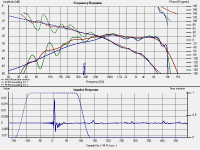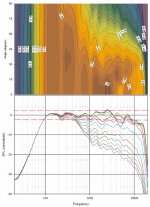maybe the first one was Ron Genereux in the Sigtech digital room correction in 1992 where he used an "adaptative filter", read his AES paper.I think that the first who did this was Doug Rife in the mid nineties with his incredible compact (550Ko) MLSSA software running under DOS. He calls this "Adaptative Window" with even two versions (Room and Loudspeaker)
Also very interesting to be read is the DRC manual
If we consider windowing length for various softwares :
for analysis soft :
Acoustisoft R+D : LF 0.5 to 2 octave resolution, HF fixed time 2 to 10ms
SMAART FPPO : 24 fixed points per octave
ARTA dual gate : HF and LF 5 to 60ms
SAT smoothFFT : near ERB ?
PRAXYS FLEXwindow : HF short window (?), mid 20 to 100ms, and full window under 50Hz
7dBmore Room Capture multiwin : small time window 0.02 to 100ms,
for correction soft in periods :
Sigtech : 2 to 7 periods
DRC : 3 to 20 or near ERB
Acourate : 10
Audiolense : 5
Trinnov : 5 to 10
Here a comparison of some windowing length (periods vs frequency)
sidenote:
jlo, are you the man behind crossvolver? If so, I cannot get it to work (that is, routing of the inputs and output of my 8ch sound cards, virtual WAV input would be prefered anyway) and there is about zero info on the net. A thread here on DIYA on it would be nice.
- Klaus
jlo, are you the man behind crossvolver? If so, I cannot get it to work (that is, routing of the inputs and output of my 8ch sound cards, virtual WAV input would be prefered anyway) and there is about zero info on the net. A thread here on DIYA on it would be nice.
- Klaus
yes, just mail me at : jl (at) ohl (dot) to, I'll be happy to help youjlo, are you the man behind crossolver?
do you mean that your window length is variable and calculated so that the resolution is xx points per octave on each part of the frequency range ?FFPO (fixed point per octave) This is in fact what I already use in the total-response
>> yes, just mail me
OK, thanks... I will summarize what my "core problems" are (still need to play more with this nice piece of SW) and will give you note, presumably tomorrow or wednesday the latest.
OK, thanks... I will summarize what my "core problems" are (still need to play more with this nice piece of SW) and will give you note, presumably tomorrow or wednesday the latest.
Ffpo?
My window is not adjusted - As I could read, e.g. in
http://www.eaw.com/Info/EAW Smaart/Manuals/FFT-Fundamentals.pdf
Then FFPO is purely smoothing in the frequency domain.
E.g.
When I smooth with 1/N and N = 1 the point in 1000 Hz is an average (windowed) from 500 Hz to 2000 Hz
See attachment
And as far as I can google this is the same as FFPO?
jlo said:do you mean that your window length is variable and calculated so that the resolution is xx points per octave on each part of the frequency range ?
My window is not adjusted - As I could read, e.g. in
http://www.eaw.com/Info/EAW Smaart/Manuals/FFT-Fundamentals.pdf
Then FFPO is purely smoothing in the frequency domain.
E.g.
When I smooth with 1/N and N = 1 the point in 1000 Hz is an average (windowed) from 500 Hz to 2000 Hz
See attachment
And as far as I can google this is the same as FFPO?
Attachments
Hey Guys,
Smaart's FPPO uses multiple FFT sizes of varying Time constants to give 24 points per octave.
For instance at 48k Sample rate(SR) an FFT of of 32K gives a Time constant(TC) of 683ms for a Frequency resolution (FR) of 1.5Hz
Broken into the approximate bands :-
0 > 125 Hz, FFT 32K, TC 683ms, FR 1.5Hz
125 > 550Hz, FFT 8k, TC 171ms, FR 5.9Hz
550 > 2kHz, FFT 2k, TC 43ms, FR 23.4Hz
2k > 8kHz, FFT 512, TC 11ms, FR 93.8Hz
8k> Nyquist, FFT 128, TC 3ms FR 3750
Hope this helps,
Smaart's FPPO uses multiple FFT sizes of varying Time constants to give 24 points per octave.
For instance at 48k Sample rate(SR) an FFT of of 32K gives a Time constant(TC) of 683ms for a Frequency resolution (FR) of 1.5Hz
Broken into the approximate bands :-
0 > 125 Hz, FFT 32K, TC 683ms, FR 1.5Hz
125 > 550Hz, FFT 8k, TC 171ms, FR 5.9Hz
550 > 2kHz, FFT 2k, TC 43ms, FR 23.4Hz
2k > 8kHz, FFT 512, TC 11ms, FR 93.8Hz
8k> Nyquist, FFT 128, TC 3ms FR 3750
Hope this helps,
Ferrit37 said:Hey Guys,
Smaart's FPPO uses multiple FFT sizes of varying Time constants to give 24 points per octave.
For instance at 48k Sample rate(SR) an FFT of of 32K gives a Time constant(TC) of 683ms for a Frequency resolution (FR) of 1.5Hz
Broken into the approximate bands :-
0 > 125 Hz, FFT 32K, TC 683ms, FR 1.5Hz
125 > 550Hz, FFT 8k, TC 171ms, FR 5.9Hz
550 > 2kHz, FFT 2k, TC 43ms, FR 23.4Hz
2k > 8kHz, FFT 512, TC 11ms, FR 93.8Hz
8k> Nyquist, FFT 128, TC 3ms FR 3750
Hope this helps
Thank you for the input

This FFPO is then a 5-time-window approach compared to the dual-time-window.
But is that a FFPO ? I lack a definition of FFPO.
The more logical thing to use is use the log sampled FFT that was published in the AES some time ago. This gives a constant number of points per decade with only a single FFT. Getting log sampled data from constant sampled data would not be too hard. Some interpolation thats all.
I'd love to see that done so that I could play arround with it.
I'd love to see that done so that I could play arround with it.
It's FPPO
Fixed Points Per Octave and basically there's 24 points per octave
hence 24FPPO 🙂
As Earl says Log spaced or Fractional octave is the way to go
(Smaart 7) hint 😉
Don Keeles paper on Log-spaced FFT http://www.xlrtechs.com/dbkeele.com/PDF/Keele (1994-11%20AES%20Preprint)%20-%20Log%20Sampling.pdf
cheers
Fixed Points Per Octave and basically there's 24 points per octave
hence 24FPPO 🙂
As Earl says Log spaced or Fractional octave is the way to go
(Smaart 7) hint 😉
Don Keeles paper on Log-spaced FFT http://www.xlrtechs.com/dbkeele.com/PDF/Keele (1994-11%20AES%20Preprint)%20-%20Log%20Sampling.pdf
cheers
askbojesen said:
You call it polar data - so I guess, that you are looking at angular dependent impulse responses.
Where can I see all your nice graphs?
Here is an example (the polar countour map, which I prefer, was too big to attach). This data was all taken, including the near field, with your system.
Attachments
I use MathCad for processing the data and SigmaPlot for the graphics.
The better looking ones are the polar maps. I'll post one of those shortly.
The better looking ones are the polar maps. I'll post one of those shortly.
back to wishes about some FPPO implementation, I think it would be better to keep a fixed time window possibility in higher frequencies, so it could be :
- a fixed time window in high frequencies of length adjustable between 1 and 20ms
- FPPO in lower frequencies with possibility to choose points per octave between 1 and 24 maybe
Another point :
now you can only choose between time-window and total response smoothing. Why not be able to choose a time-window together with smoothing ?
Some work again for you, Ask, sorry...
- a fixed time window in high frequencies of length adjustable between 1 and 20ms
- FPPO in lower frequencies with possibility to choose points per octave between 1 and 24 maybe
Another point :
now you can only choose between time-window and total response smoothing. Why not be able to choose a time-window together with smoothing ?
Some work again for you, Ask, sorry...
Hi JL-O
I've sent you mail (twice) thru the forum but have not gotten any reply. Maybe it is not getting to you?
I've sent you mail (twice) thru the forum but have not gotten any reply. Maybe it is not getting to you?
sorry Panomaniac, I received nothing so please send it directly to jl(at)ohl(dot)to (I'll also check carefully my spambox !)I've sent you mail (twice) thru the forum but have not gotten any reply. Maybe it is not getting to you?
jlo said:Another point :
now you can only choose between time-window and total response smoothing. Why not be able to choose a time-window together with smoothing ?
Some work again for you, Ask, sorry...
I'm aware of that feature could be nice. Especially with log-sweep where we want to neglet the HD-pre-tops
Thnak you for the input regarding smoothing/time-windowing
In general I'm thinking about smoothing - I'll be back

- Home
- Design & Build
- Software Tools
- HOLMImpulse: Measuring Frequency & Impulse Response

